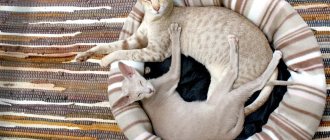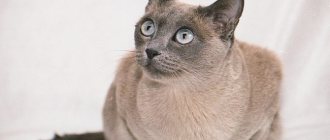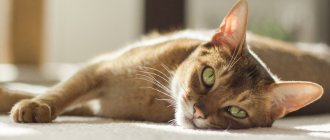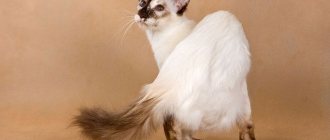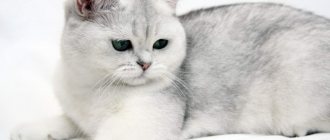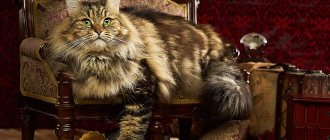| Country of origin | Thailand, UK |
| Dimensions and weight | 4-6.5 kg, length - 60 cm |
| Wool | short, there is a semi-long variety |
| Lifespan | 13-16 years old |
Graceful, slender, sophisticated, incredibly flexible - that's all she is - an oriental cat. But the apparent fragility of these animals is combined with excellently developed muscles and a love of movement. Orientals belong to the Siamese-Oriental group of cats. Therefore, representatives of the breed are often called “Asians”, “Orientals”, “Oriental”, “Orik”, “Ori”. There are other names, some of them are already outdated: cat greyhound, shorthaired pointer, oriental shorthair.
History of the breed
The Oriental Shorthair is a cousin of the Siamese cat. More precisely, it is one breed, but with different colors and eye colors. Siamese have a light body, blue eyes, Orientals have a fully colored body and green eyes. There are no more differences, not even in character.
In ancient Thailand, the Oriental cat was one of the varieties of Royal Siamese cats, which were revered in the imperial palace and temples.
Part I
The ancestors of the Siamese and Orientals were brought from Thailand to England at the same time (late 19th century). There is information that at an exhibition in London in 1896, an oriental cat of a solid blue color was presented. But she was disqualified because there was no Siamese color. The popularity of the Siamese with its point coat and blue eyes has eclipsed the Orientals. And in 1923, the British Siamese Cat Club finally excluded solid green-eyed cats from the Siamese class. All activities related to breeding the breed were stopped.
Part II
After World War II, as the Siamese population declined, some breeders returned to breeding colored cats. First, work began on breeding chocolate-colored oriental cats, which were given the name Havana. A number of historians claim that the shade of the wool is comparable to the rich color of a Havana cigar, hence the name. Then they started breeding lilac orientals, with different colors and patterns.
Part III
An equally interesting story began in America. In 1956, the chocolate cat ended up in California (USA), where they almost immediately began to recognize it as a new breed. In 1964, the CFA approved the independent Havana Brown breed, giving it champion status. Therefore, in Europe, Havana Brown is a chestnut color, and in America it is a separate breed. The same story happened with white Asians, who in 1974 received breed status under the name “Foreign White”.
To obtain new colors, breeders infused Asian cats with the blood of American Shorthair, Abyssinians, Burmese, and Russian Blues.
After this, a campaign began to recognize solid Siamese cats as a separate breed. Already in 1977 the standard was approved. This year and the next, the Oriental breed was at the peak of its fame, entering the top ten most popular. The only exception was for cats with bicolor colors. But in 1995, justice triumphed - the color was recognized.
Oriental semi-longhair cats
In the 80s In the 20th century, oriental cats with long hair, called British Angora, were registered in England. The breed was recognized by the largest felinological system - GCCF. In 2003, the name was changed - the British Angora became the Oriental Longhair.
In America, a cat with silky long hair, a feathered tail and a small beard was the result of crossing a shorthaired Oriental and a Balinese. The kittens received a Balinese build and semi-long hair, but the color remained oriental. In 1997, Oriental Longhair was recognized in the USA.
The Oriental Longhair breed has other names - Oriental Longhair, Mandarin.
Description of the breed
The appearance of the oriental cat provided another interesting name - “greyhound of the cat world.” A beautiful, graceful body, long legs, a whipping tail, an elongated muzzle with expressive eyes and large ears make the image of the Oriental recognizable.
The standard is very similar to the Siamese breed standard. Only in the description of the head and body the word “medium” was replaced with “long”. And also, unlike the Siamese and Thai cats, the fur of Orientals does not change tone due to climatic conditions and hormonal changes.
The Oriental breed is a medium-sized cat. As with other breeds, males are much larger than females. So, the average weight of a male is 4.5-6 kg, a female weighs 3-3.7 kg. Body length without tail is on average 60 cm, height – up to 35 cm.
The standards of the leading felinological systems differ little from each other when assessing the Oriental breed.
Breed standard:
| Become | Description |
| Head | The skull is a well-defined wedge. The nose is straight and long. There is no transition from nose to forehead. The chin is strong, strong, but not massive. The neck is long and slender. |
| Ears | Wide at the base, tapering towards the tip. Set low and wide. The size is very large. The tips of the ears should not droop. |
| Eyes | They are shaped like almonds. The color is rich green without inclusions. An exception is for white orientals, in which blue or different colors are acceptable. |
| Body | Elongated, toned, with well-developed muscles. Shoulders are no wider than hips. |
| Legs | Slender, long, with developed muscles. The hind legs are longer than the front ones. Thanks to this, Orientals are distinguished by their jumping ability. Small, oval paws. |
| Tail | Thin, sharp at the tip, without creases or knots. The length is in harmony with the body, reaching the shoulder blades or a little further. |
| Wool | Very short, silky (with a satin effect), close to the body. There is no undercoat. The Oriental Longhair cat has flowing, fine fur. Because the hairs fit tightly to the body, the fur appears shorter than it actually is. |
Rainbow colors
Representatives of the Oriental breed have more than 300 color varieties. For such abundance, the Oriental Shorthair received the nickname “rainbow cat.”
With all the variety of colors, patterns and types, the color of the eyes is exclusively green.
Solid colors
- Ebony (ebony). One of the most beautiful, making the cat look like a black panther. The fur is completely jet black from tip to root, without a hint of rusty hairs. The same black paw pads and tip of the nose.
- Chestnut (chocolate, Havana). Uniform, warm chestnut brown color. An animal with a Havana coloration looks very exotic.
- Lavender (lilac). The fur is pink-gray, as if covered with frost. But the color should not be too blue or fawn. The nose and paw pads are pinkish-lilac.
- Blue. The coat is uniformly blue, without a hint of silver or rust. The paw pads and nose are the same.
- Red. Monochromatic, no patterns or shades.
- Cream. Pure color preferably light tones.
- Tortoiseshell. There are spots scattered all over the cat's body. This happens if the main coat color is diluted by a red or cream color.
- Faun. Light beige color, which is called the “color of a young fawn.”
- Cinnamon (cinnamon color). All chocolate brown tones: brown, sandy brown (not red) with copper or bronze undertones. Markings may be visible on light coats - this is acceptable, but preference is given to a richer, purer color.
- Smoky. A variation when, with the main or tortoiseshell color, the lower part of the hairs remains white due to the lack of pigment.
- White. Pure white color without a hint of yellowness. The eyes of such cats can be blue, green, or one blue, the other green.
Tabby colors
Patterned colors such as brindle, harlequin, ticked, and spotted are common. All varieties are characterized by the letter M on the forehead, lines from the outer corners of the eyes to the back of the head, several necklaces on the neck, 2 rows of dots running along the chest and stomach. Rings cover the legs and tail.
Varieties of patterned colors:
- Brindle. A narrow continuous line runs from the back of the head to the tail. The entire body is covered with stripes running from the spine to the lower abdomen.
- Spotted. It is similar to a brindle, but the longitudinal and transverse stripes are divided into spots of different shapes - round, oval.
- Marble. Lines run from the head to the shoulders, forming a butterfly-shaped pattern. Three parallel lines can be traced along the back from the “butterfly” to the base of the tail. On each side there are spots symmetrically located, surrounded by one or more rings.
- Ticked. There is no pattern on the body, but each hair consists of alternating areas of dark and light color.
A wide variety of colors and shades
The colors of Oriental cats are very multifaceted. The breed is very diverse and felinologists accept all types of oriental colors. By the way, this is one of those breeds for which no special requirements apply in terms of color.
And yet, the colors are systematized. The main and most popular ones are:
- Red.
- Lavender.
- Blue.
- Brown.
- White.
- Black.
- Beige.
- Cream.
A combination of white and red or cream with stripes and spots is not prohibited. Plain orientals look very beautiful. Like panthers, black and brown tones, with and without spots.
Character of an oriental cat
All oriental cats have a unique character. Orientals are no exception. Developed intelligence, intelligence, quick wit, affection for the owner, playfulness, talkativeness and eternal busyness - these are the main characteristics of the breed. And the behavior is called nothing less than “dog-like.”
Orientals are one of the most talkative cats. These are very emotional animals. They are not shy about purring, purring loudly just to express their feelings. But not idle. If a cat purrs, it means he needs to speak out: perhaps something hurts, or he is scared or, conversely, happy. Any action does not take place silently, but is accompanied by “conversation.” He will not shake the air while no one is home. He needs a person to communicate.
It is not known what Orientals love more - chatting or being close to the owner. Ori are loving, and become so attached to their owner that they can become depressed if he is absent for a long time. This breed is recommended for people who spend most of their time at home. Either take 2 cats into the house at once or get some other pet. Orientals are friends with everyone. They get along well with children and enjoy playing with them. Get along well with other animals. The adjustment period takes very little time. They find a common language quite quickly even with a dog. Only first they will try to take the position of leader. If the dog does not agree, conflict cannot be avoided. Here the owner’s task is to help make friends between the cat and the dog.
Eastern cat and its features
The name of the representatives of the breed gives some idea of themselves, because from English “oriental” is translated as “eastern”, which makes the cat a rather mysterious breed.
Indeed, it is extremely difficult to find cats similar to oriental ones, because our world does not know many oriental species. For example, consider the Eastern Siamese, which, as an Oriental Shorthair breed recognized by the cat fanciers' association, has the distinguishing feature of only coat colors and different colored eyes. Also, compared to Siamese cats, the Oriental cat is distinguished by the absence of any special darker markings on the tail, face and paws that distinguish the Siamese cat from other cats. The Oriental cat has a uniform coat of pure colors throughout its body. Many features of these cats represent the best - taken from wild genetically inherent qualities, for example, Oriental cats are graceful, have a relief constitution, long and flexible bodies.
According to their conformational characteristics, oriental cats have long, elegant legs and a beautiful, rounded head. The cute, attractive face has large, expressive almond-shaped eyes and medium-sized ears. Cats captivate others with their proud posture, graceful plasticity of movements, grace and elegance.
Oriental
When buying a pet Oriental animal, you get, first of all, a friend who can be trained very well, since the Oriental cat carries out most of the complex commands, because cats also have high intelligence. The pet is immediately attached to its owners, sociable, sincerely loves and trusts. Your representative of the Oriental Shorthair will always find something to do and entertain himself; cats are quite curious, so almost everything that happens around them will be examined and investigated.
Pets will be members of your family, always helping and maintaining friendliness. If small children live nearby in a house where cats live, then oriental cats will happily entertain the children by playing with them. They do not understand that the baby wants to sleep and is generally still too small; they will persistently try to climb into his crib. Therefore, if you have a newborn baby, it is better not to adopt an oriental cat. She will be a great friend and playmate for older children.
Training a pet is in many ways perceived as a game, so the owner can easily teach the pet to perform many exciting commands.
Show cats that it is best to walk on a leash, due to their excessive activity and the danger of running away. While playing on the street, a cat of an oriental breed can easily be taught the “Fetch” command, by which it brings some object, a stick or a ball, thrown by the owner. Other inhabitants of the house or street where Oriental Shorthair cats live will definitely become friends, because the Oriental cat is a conflict-free cat, peace-loving and friendly.
Care and maintenance
Oriental cats do not require any special care. However, it is up to the owner to ensure that the pet lives longer, is healthy and happy.
The Oriental needs daily exercise and play that stimulates its natural instincts to hunt and explore. Therefore, it is better to keep your cat's body and mind active, otherwise behavior problems may develop.
In addition, due to their activity, Orientals are the cats that fall out of windows more often than others. Therefore, when keeping an apartment above the 2nd floor, nets on the windows and a glazed balcony are required.
Grooming
The lack of undercoat and short hairs do not cause trouble to the owner. Of course, Orientals also shed. But it is enough to comb them periodically with a rubber brush or a special glove. There is practically no wool on clothes or furniture. Mostly it accumulates in the resting place.
Tangerines have a small undercoat, which gives them more wool. Brush the animal 1-2 times a week, every day during shedding.
Water treatments
Orientals are bathed only when they are heavily soiled, for example, by accident, or before an exhibition. Most cats do not like to bathe, and the Oriental is no exception. It is important after washing to prevent the animal from getting into a draft.
Nail care
Claw trimming is carried out every 2 weeks. But these terms are arbitrary; some pets will need to do this every 10 days, others – once a month. The procedure is carried out with a special tool (nail clipper) so as not to damage the claws.
Care for ears, eyes, teeth
An obligatory part of care is cleaning the ears, eyes and teeth. They are accustomed to the procedure from infancy, otherwise the cat will resist.
Wipe the ears and eyes with a cotton pad soaked in warm boiled water or a special lotion.
Cats don't take very good care of their teeth. Without additional help from the owner, there is a risk of dental disease. Typically, it all starts with plaque, which should be combated by regular brushing.
Deworming
Prevention of worms is a mandatory procedure. It is carried out 10 days before vaccinations and preferably every six months. There are a lot of deworming drugs. The dosage of almost all is selected by weight. Veterinarians recommend choosing complex medications that act on different types of worms.
Toilet issue
All kittens in the nursery are already litter box trained. And at first it is better to use the same type of tray that the breeder had. This way the kitten will adapt faster and learn to go to the right place.
Orientals love to dig. Therefore, it is better to choose a tray with high sides or a toilet-house. Any filler your pet likes.
How long do oriental cats live?
Oriental cats have a fairly typical lifespan for felines - an average of 5 years, but there are also centenarians. With proper care, nutrition, and the absence of genetic diseases, the Oriental, without losing its playfulness, can live up to 20 years.
Is the Oriental cat hypoallergenic?
The Oriental Shorthair has short hair, so it does not shed as much as other breeds. Researchers also believe that Orientals produce less protein, which is the main allergen. These 2 facts became the basis for including the Oriental cat in the list of hypoallergenic breeds. However, no breed is 100% allergen-free.
Myths and real facts
There is an opinion that oriental cats make unpleasant sounds. This happens, but rarely. It depends on the nature of the animal and the attitude of the household towards it. If the pet is on friendly terms with the owner and all family members, then the cat will not be excessively intrusive and loud.
Another myth is that Orientals like to climb curtains. In fact, only kittens do this. Having matured, they become well-mannered and do not cause damage to the interior.
An Oriental cat can become a truly loyal friend and companion for the rest of its life. With proper care, they will easily celebrate their twenty-year anniversary. At the same time, they remain just as active, funny and playful, which is confirmed by numerous reviews from the owners.
Feeding
Orientals value a fit and muscular body, so they should not be overfed. But representatives of the breed are big food lovers. They will constantly demand food. If the owner refuses for some reason, then theft has not yet been abolished. They will find it, steal it, eat it. Therefore, you cannot follow the lead. One or two “begged” treats and the oriental will already “twist the ropes” out of the owner, and begging for a tidbit will become a habit. However, excess weight in cats not only spoils their appearance, but also causes health problems.
Natural nutrition
Orientals are not picky when it comes to food, but the diet must be balanced. This is not easy to achieve with natural feeding. However, if the owner is a supporter of natural nutrition for his pet, then when preparing and calculating the dosage, the following must be taken into account:
- A cat consumes 5 to 10% of its own weight per day in food. Kittens and young pets eat more, but with age the appetite becomes moderate. Of course, everything is individual, the main thing is that the cat gets enough to eat.
- As a percentage, daily feeding is 3https://68koshek.ru/soderzhanie/pitanie/perevesti-koshku-na-drugoj-korm0% meat (chicken, veal, chicken stomachs, hearts, necks), 25% vegetables (zucchini, pumpkin, carrots), 20% porridge (rice, buckwheat), 25% fermented milk products (cottage cheese, kefir, fermented baked milk, yogurt, yogurt).
- All new products are introduced into the diet carefully to avoid problems with the gastrointestinal tract and the development of food allergies.
Attitude towards children and family
Representatives of the breed cannot say that they love children very much, but they are tolerant of them. They will never use their claws, even with an unintentionally careless attitude towards themselves. However, little pranksters will not be allowed to invade their personal space.
Family
The only disadvantage of oriental cats is possible jealousy of the owner when he pays more attention to the children. Sometimes, the desire to always be the center of attention leads to certain difficulties in communicating with a cat.
Health
Shorthaired Orientals and Mandarins have excellent health and strong immunity. But there is still a predisposition to certain diseases:
- Gingivitis is an inflammation of the gums that, without timely treatment, develops into periodontal disease.
- Cardiomyopathy is a heart disease in which the walls of the ventricle harden. The volume of the heart chambers decreases, which leads to the development of heart failure.
- Retinal atrophy is a hereditary defect in which the visual cells of the retina are destroyed, which leads to partial or complete blindness. The disease occurs both at a young age (3-4 months) and at a later age (after 4-5 years).
- Flat chest syndrome is a hereditary pathology. The chest becomes flat or funnel-shaped. The problem is identified immediately after the kitten is born.
Pros and cons of the breed
According to reviews from owners, the Oriental breed has many advantages, but there are also disadvantages, if you can call them that.
Good companion
Gets along well with children and other animals
Loving, affectionate, gentle
Easy to learn and trainable
Very talkative, she will definitely insert her meow on every occasion
Can be annoying, as it follows the owner's heels
Unable to remain alone for long periods of time
Approximate prices
In Russia, you can buy an Oriental breed kitten for approximately the following amount of money:
- In a nursery or from a professional breeder (an animal with a pedigree, veterinary passport and card) - from 20,000 to 40,000 rubles .
- At the pet market (pet without a pedigree, but with a veterinary passport) - from 10,000 rubles .
- According to an advertisement on the Internet or in a newspaper (a cat without a pedigree and veterinary documents) - from 8,000 rubles .
How to choose a kitten
When choosing and purchasing a purebred Oriental kitten, it is important to know:
- The breeder will not give away the kitten until it is 3 months old. If they sell smaller kittens, this is a reason to think about it.
- Each purebred kitten must have a birth certificate (birth certificate) or pedigree if it is a show kitten. A pet without documents is not a real Oriental.
If you have doubts whether the litter has been registered, you can always check with the club in which the nursery is listed.
At the age of 2 months, the litter is assessed (actuation). Kittens are divided into 2 categories: those who participate in further breeding and those who do not. The cost of the kitten depends on this. On average, it starts from 20 thousand rubles.
There are too many factors that influence the price. The main one is the type of kitten. The extreme type is valued higher - eared, with a long muzzle, thin bones, and very short hair. All breeders strive to get just such kittens. The price for them starts from 40 thousand rubles. Of course, the cost is determined by color, quality (the presence of defects reduces the cost), and the purpose of purchase (for breeding or castration). Therefore, the price for a kitten as a pet can be 100 thousand rubles, and with the right of breeding 120 thousand and more.
